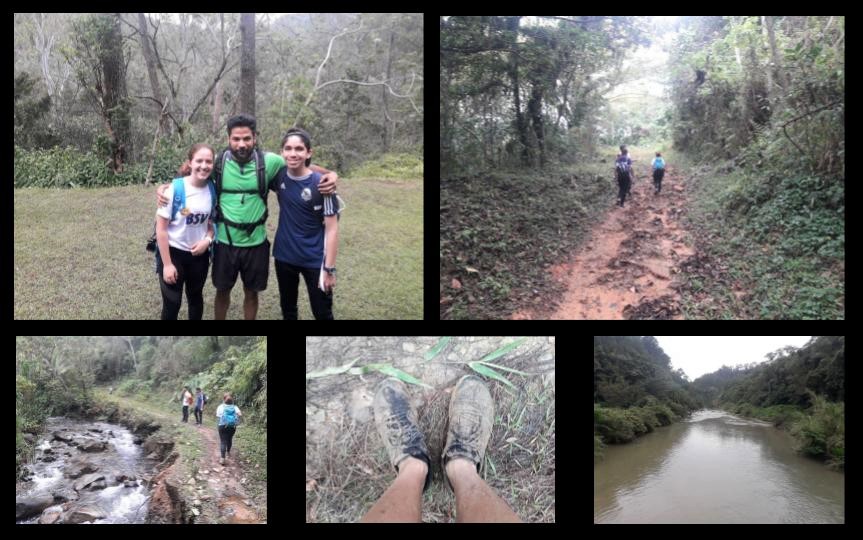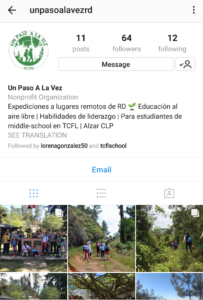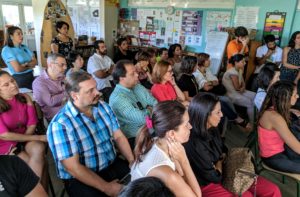The Outdoors Club: A Student Leadership Initiative
When we say we want our students to become “lifelong learners,” we’re not simply talking about academics. Beyond the math and reading skills we teach them, we also focus on 21st century skills like communication, critical thinking, and leadership. Although many of these skills are not immediately discernible, over time we see the way our students mature and develop, eventually watching them share ideas and take the lead in projects. Recently, we had the pleasure of seeing one of our 10th grade students take an idea she was passionate about and run with it.
Andrea Rodriguez, is a self-motivated 10th grade student who is honing her leadership skills. She has always had a strong interest in the outdoors, hiking the mountains of the Dominican Republic whenever possible. After studying abroad for a semester at Alzar school in the U.S., where she took part in outdoor learning, she came home with a desire to pass on her love of nature and the outdoors to other students. She wanted the learning to be taken outside and she began to look for ways to make that happen.
Andrea envisioned an outdoor club that would be open to students from all over Santo Domingo. She says, “I wanted to start with middle school, because they’re more malleable. High school kids are already more interested in parties and their phone and I thought it would be harder to interest them. But middle schoolers still have wider interests and I thought that if they could start hiking at this age, some of them would want to continue on through high school.”
Throughout her project, Andrea would have to show a wide range of leadership skills: strong communication skills, the ability to motivate others, a positive attitude, trustworthiness, and responsibility. She would have to motivate students to take part, convince teachers and parents that her idea had merit, do a great deal of planning, and delegate tasks to people she could trust.
Planning and Collaboration
She approached several teachers with her idea and they suggested doing a trial run in our own school before opening it up to other schools. Andrea decided to work with 5th and 6th grade students and began organizing. She decided that she’d like to integrate academics into the hike as well and make it an exploration out in the field.
Knowing that she would need help to get her project off the ground, Andrea formed an action team comprised of teachers and Khalil Chame, a classmate who had gone on several hikes with her to Pico Duarte (the Dominican Republic’s highest mountain) and who volunteered to become her partner in the project. She spent a weekend with Khalil and Dennis, one of her science teachers scouting the Ebano Verde Science Reserve for possible hiking trails.
After scouting several possibilities, the team decided on an overnight camping trip with two day hikes. They planned several activities that would also take place, including team-building activities, biology lessons while exploring the flora and fauna of the area, and trail games “to take the kids’ minds off the fact that they have to hike 10 kilometers,” Andrea said with a laugh.
Communication
Andrea held a number of meetings to get her project rolling. She started by conferring with the head of the middle school and the school psychologist to get their feedback. Beforehand, she reflected on any questions or concerns they might have. She knew safety would be an issue and when they asked her about risk management she had her answers ready: she had already recruited teachers who agreed to accompany her on the trip and a paramedic would be there in case there were any acccidents.
Then she met with the 5th and 6th grade students to share her enthusiasm and generate interest. Knowing that if she couldn’t get the students on board, her idea wouldn’t fly, she opened her talk with a game called “Rock, Paper and Scissors Olympics” a quick tournament of the classic game. She said, “My intention was to have them blow off some steam so that they would be able to pay closer attention to the presentation afterward. Still, we made the presentation ‘short but sweet’. We gave a quick overview of the trip, careful not to bore them with the logistics, and then answered any questions they had.” Needless to say, she hooked them.
She also created an Instagram account, “Un paso a la vez,” where she shared the steps she was taking to put her idea into action.
The parent meeting would be the toughest. She had to convince parents that her trip was well-planned and that their children would be safe on the overnight trip. She focused on the fact that there would be an instructor for every four students, that they carried first aid kits and a paramedic was available. But she also emphasized the positives outcomes of letting their children explore on their own:
- Gaining self confidence.
- Developing communication and social skills.
- Increasing their motivation, concentration and creativity.
- Gaining a deeper understanding of and interest in nature and biology.
- Developing a stronger learning community.
Much to everyone’s surprise, most of the parents embraced the idea, leading to a new issue:
Problem Solving
At the start of the project, Andrea had simply hoped she would be able to convince enough kids to join her in order to have a successful first trip. However, she ended up facing an unexpected problem: the interest was overwhelming and she couldn’t include all the students who wanted to go. Because she wanted to make sure no one felt left out — and in order to keep everyone happy — she had to expand her idea and offer two expeditions. She got to work recruiting extra volunteers and putting together all the logistics for a second trip.
Feedback
The end result was extremely positive. One of our 5th grade teachers, Laura Gomez, had this to say about the adventure:
The trip to Ebano Verde was such an amazing, enriching experience. I enjoyed every minute of it and I know the kids did as well — they’re still talking about it weeks later! I applaud Andrea’s initiative and the fact that she took this age group into consideration for this type of activity, as I feel like now, more than ever, kids need to realize that there are so many alternatives to staying at home playing video games, watching TV, etc. Something I keep hearing from many of my kids is the fact that they want to continue doing this in years to come, so I’d say that a seed has definitely been planted in them!I was also incredibly moved by my personal experience with one of my former students, witnessing him challenging himself and not giving up when the hike got tough. It was inspiring to those of us who were there with him and I know it was important for him to have this experience.
Students and teachers loved it and can’t wait for the next trip!
When I asked Andrea what her ultimate goal was, she said, “I’d like to see this turn into something more permanent. I want it to become a tradition and I envision students in a variety of grade levels interacting with each other. As kids outgrow the trips, I want them to become the leaders who take on and experience a different role.”
Student leaders creating student leaders — what better way to empower our students?






So inspirational!
Wow – this is amazing! I love the way Andrea shared her passion, and I love how the teachers, staff, & parents got behind her to allow her to implement this BIG vision. As a teacher who has put together overnight field trips for students, I know how much work it is, and I’m so impressed that she pulled it off. It’s clear that the 5th & 6th graders enjoyed it and learned a lot, making it 100% worth it!